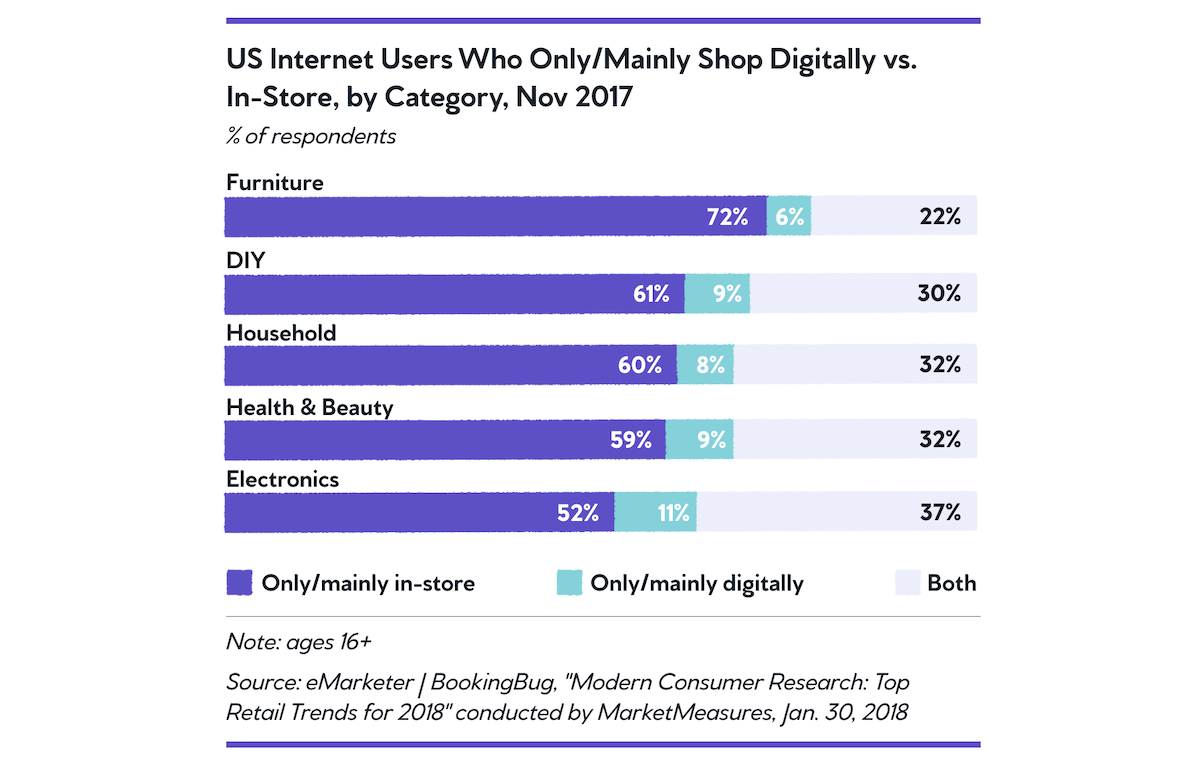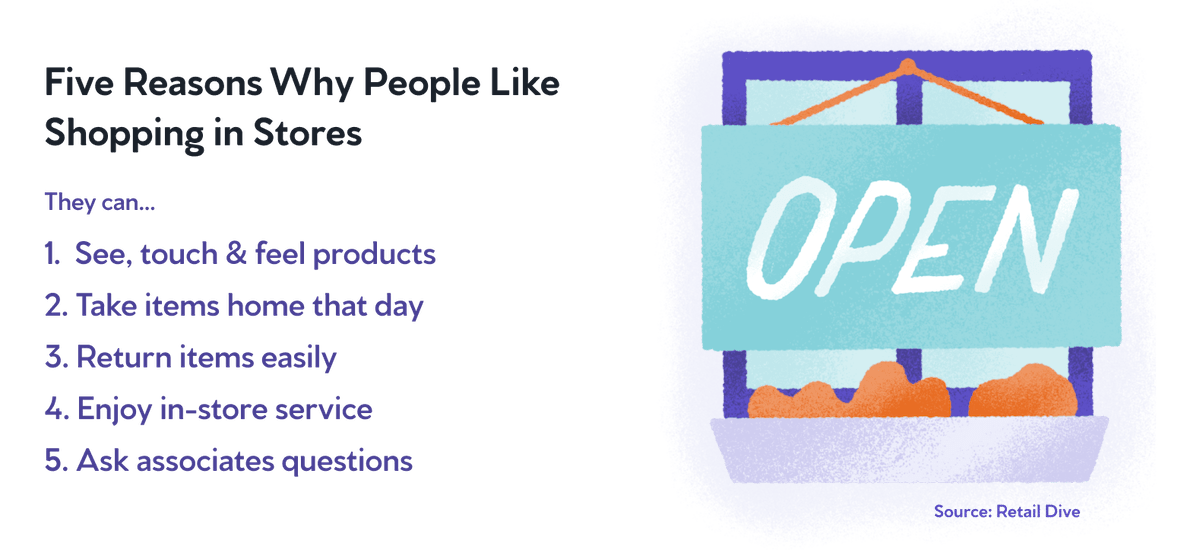Pure Play vs Omnichannel Ecommerce: What’s Best for Your Store?

There’s no doubt that the ecommerce industry has seen explosive growth in recent years. Global ecommerce sales have more than tripled from $1.077 trillion in 2014 to an estimated $3.914 trillion in 2020.
But these numbers need to be put into context—they’re still just a fraction of the sales made in traditional brick-and-mortar stores.
For example, in Q1 2020, ecommerce sales only represented 11.8% of total retail sales in the U.S.
Indeed, in most product categories, shoppers still make the bulk of their purchases in-store rather than online.

When you look at this data, it’s clear why many of the online businesses that start out as pure play ecommerce stores eventually consider switching to an omnichannel approach.
#cta-visual-pb#<cta-title>Build a better Shopify store<cta-title>Make your store look and feel as unique as your brand by customizing with the best page builder for Shopify.Start building for free
What is pure play vs omnichannel ecommerce?
There are two types of ecommerce: pure play and omnichannel.
Pure play ecommerce involves businesses that only make sales via their online storefronts. For example, marketplaces like Etsy as well as direct-to-consumer brands like Leesa.
Omnichannel ecommerce involves businesses that operate both physical and online storefronts.
Considering the aforementioned growth of ecommerce, it’s no surprise that the biggest retailers opened up online stores of their own—the top omnichannel ecommerce brands include Walmart, Target, and The Home Depot.
And of course, many local brick-and-mortar shops have launched websites in order to boost their sales as well.
#cta-paragraph-pb#Learn about the benefits of leveraging omnichannel analytics and data for more effective marketing campaigns.
#cta-visual-pb#<cta-title>Convert more of your website visitors<cta-title>Shogun lets you easily create a visually appealing storefront to turn more of your pure play and omnichannel shoppers into buyers.Start building for free
Pros and cons of pure play and omnichannel ecommerce
Let’s go over how pure play and omnichannel ecommerce compare across a variety of metrics, including cost, online customer experience and overall customer experience.
You should keep in mind that the pros and cons will vary based on your specific industry and goals, but this general overview should still help you determine which approach is best for your business.

1. Cost
Both pure play and omnichannel ecommerce businesses must take on the costs of running an online store. This includes:
- Web hosting: Your ecommerce site will need to be hosted on a server in order to be available to customers. This can be as low as 99 cents per month, but you should expect it to be closer to $9.99 per month. As the traffic to your site increases, your hosting expenses will increase as well. Also, all-in-one ecommerce platforms such as Shopify and BigCommerce include hosting in the cost of their plans.
- Web design: If your site isn’t visually appealing and easy to navigate, you’ll find it quite difficult to convert the people who visit your store into customers. Entry-level web designers make an average salary of $42,955, and their average hourly rate is $17.27. Experienced web designers make an average salary of $58,010, and their average hourly rate is $27.75.
- Order fulfillment: In most cases, ecommerce merchants should hire a third-party logistics (3PL) provider instead of handling order fulfillment themselves, as warehouse space and equipment requires enormous upfront costs and is difficult to scale. 3PL companies typically have different rates for fulfilling orders and storing inventory — for example, Fulfillify charges a fulfillment fee of $1.99 for the first item in an order, plus an extra fee of 50 cents for each additional item in the order. Fulfillify also charges a monthly fee of $12.50 per pallet for product storage.
Pure play businesses can expect more shipping expenses, but this cost can be reduced by using an order fulfillment service rather than investing in your own warehouse space and equipment.
With omnichannel ecommerce, businesses also need to pay for the rent and utilities of their physical storefronts, as well as the wages and benefits of the staff that’s required to operate them.
This makes it significantly more expensive to run an omnichannel ecommerce business.
Advantage: Pure play

2. Online customer experience
Pure play ecommerce businesses are able to dedicate all of their time and money to their website, while omnichannel companies must split their resources between their website and their brick-and-mortar locations.
So, it should be no surprise that pure play businesses tend to offer a better online experience.
Specifically, research shows that customers give pure play online stores higher ratings for site search, account management, ease of finding information and support than omnichannel stores.
To give omnichannel stores some credit, the same research shows that customers believe they have better page design than pure play stores.
This is likely due to the fact that omnichannel retailers are drawing from their experience with physical catalog design, which has always emphasized clean aesthetics, while pure play stores are more influenced by Amazon’s takeout menu-like design, which is effective for sales but isn’t exactly easy on the eyes.
Having an attractive website is important, but the nuts and bolts of the ecommerce experience is even more so.
If visitors can’t find what they’re looking for within 15 seconds, they’ll likely back out and look for another option that’s easier to navigate.
It appears that omnichannel stores still have some catching up to do in that regard.
Advantage: Pure play

3. Overall customer experience
There have been many stories written in recent years about the rise of ecommerce, and it has indeed been growing at a quick pace.
For example, ecommerce sales in the US grew by 14.9% in 2019, but the slower growth rate of brick-and-mortar sales dragged total retail growth to just 3.8% over the same period.
These numbers must be put into context, though.
When you look at where ecommerce and brick-and-mortar retail stand now instead of how fast they’re growing, ecommerce doesn’t look nearly as impressive. U.S. ecommerce sales totaled $601.75 billion in 2019, which was 16% of the $3.763 trillion in total retail sales.
In other words, the vast majority of purchases are still being made in-store.
Pure play ecommerce stores may offer a better online experience than omnichannel stores, but they also have some significant limitations.
According to consumers, the biggest drawback to shopping online is that they can’t physically inspect items before they purchase them—high-quality images and video are helpful, but there’s just no substitute to checking out a product in person.
Also, in-store shopping allows consumers to avoid the cost and delay of shipping.

Another factor is that some people simply enjoy the experience of going to the store.
This seems somewhat counterintuitive. Who wants to drive to a business and physically search through shelves to find what they want to buy when instead, they could quickly purchase the same products from the comfort of their own home?
But in our increasingly atomized society, with everything from work to school to entertainment often done inside rather than outside the home, people are craving human interaction now more than ever.
Going to the store gives shoppers a chance to see and talk to other people face-to-face—and if you make a good impression, you’ll give customers a reason to stay loyal to your brand and ignore all of your competitors.
Given these benefits, it makes sense that 85% of consumers report they favor brick-and-mortar stores over ecommerce sites.
Seventy-one percent even say that they would prefer to shop at a physical Amazon store instead of Amazon’s website.

Perhaps this is why Amazon, previously the king of pure play ecommerce, started dipping its toe into brick-and-mortar retail five years ago.
Its first physical location was a bookstore in Seattle—which is ironic, of course, considering that Amazon’s initial success led to the closure of countless brick-and-mortar bookstores in the ‘90s and ‘00s.
In addition to Amazon Books, the company’s physical footprint now includes the Amazon Go cashless convenience stores and the Amazon 4-star stores for general merchandise.
With Amazon’s acquisition of Whole Foods in 2017, it now operates over 400 grocery stores as well. Altogether, this adds up to over 20 million square feet of physical retail space.
If the most successful ecommerce company in the country is investing this heavily in omnichannel, then there certainly must be some value to this sales model.
And while Amazon is the biggest company to go from clicks to bricks, it’s far from the only one.
The mattress company Casper started as an online-only store, but it now has plans to open 200 brick-and-mortar stores by 2021.
Warby Parker, Glossier, and Indochino are just a few of the other brands that have also recently invested in physical storefronts. The previously pure play footwear company Allbirds went as far as to open a 4,800 square feet location in the heart of New York City.
With Amazon and so many other ecommerce companies pivoting from pure play to omnichannel, you might consider doing so as well.
Advantage: Omnichannel

#cta-visual-pb#<cta-title>Create an exceptional ecommerce experience<cta-title>No matter where your site visitors come from, Shogun helps you inspire and engage them with a visually stunning storefront.Start creating for free
So who’s the winner, pure play or omnichannel?
Well… it depends. (But you kind of knew that was coming, didn’t you?)
The only way to decide between pure play and omnichannel ecommerce is to look at the specific needs and resources of your business.
If you have enough capital for it, the benefits of omnichannel ecommerce could make it well worth your investment.
On the other hand, if you’re on a tight budget, with the pure play model you can make a lot of sales while keeping your costs down.
You should consider your industry and product line as well. If you sell popular products that are often bought impulsively (apparel, electronics, etc.), a physical storefront can effectively convert random passersby into paying customers.
Most clicks-to-bricks stores are located in trendy neighborhoods within major cities.
There are a lot of tourists and foot traffic. Can you picture your business in that environment? If you focus on more niche products, such as medical supplies, a transition from pure play to omnichannel might not work out for you, even if you do have the resources to open up a brick-and-mortar store comfortably.
You’ll want to take a good look at your business and do some research before making any decisions. After all, the best sales model for one business isn’t necessarily the best for another.
#cta-visual-pb#<cta-title>Transitioning from pure play to omnichannel?<cta-title>Shogun’s Page Builder ensures your brand has an unforgettable online presence to turn brick and mortar browsers into online buyers.Start designing today

Adam Ritchie
Adam Ritchie is a writer based in Silver Spring, Maryland. He writes about ecommerce trends and best practices for Shogun. His previous clients include Groupon, Clutch and New Theory.



